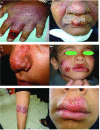Geographical distribution and molecular characterization for cutaneous leishmaniasis species by sequencing and phylogenetic analyses of kDNA and ITS1 loci markers in south-eastern Iran
- PMID: 29536818
- PMCID: PMC6056826
- DOI: 10.1080/20477724.2018.1447836
Geographical distribution and molecular characterization for cutaneous leishmaniasis species by sequencing and phylogenetic analyses of kDNA and ITS1 loci markers in south-eastern Iran
Abstract
This study aimed to explore geographic distribution and molecular characterization of cutaneous leishmaniasis (CL) species by amplifying two popular markers in kinetoplast DNA and internal transcribed spacer 1 loci by nested-PCR, and characterized by sequencing and phylogenetic analyses. Findings demonstrated that two species co-existed in the province: L. tropica (88.5%) and L. major (11.5%). All gender and age groups were equally infected, although males, 21-30 years old, exhibited a significantly higher infection. Sequencing and phylogenetic analyses of 34 randomly selected samples showed that L. tropica isolates exhibited some degree of heterogeneity. Both anthroponotic CL and zoonotic CL are present in south-eastern Iran with predominance of L. tropica species. Some level of heterogeneity was observed in L. tropica isolates which possibly reflects different colonies in the area. Implementation of diagnostic tools directly from clinical samples could be an important strategic approach for exploration of spatial distribution, molecular characterization and phylogenetic analyses.
Keywords: Cutaneous leishmaniasis; Iran; geographical distribution; molecular characterization; phylogenetic analysis; sequencing.
Figures


 ) and Leishmania major (
) and Leishmania major (
 ) in Kerman Province, south-eastern Iran. Source:
) in Kerman Province, south-eastern Iran. Source: 





Similar articles
-
The Geographical Distribution of Human Cutaneous and Visceral Leishmania Species Identified by Molecular Methods in Iran: A Systematic Review With Meta-Analysis.Front Public Health. 2021 Jun 25;9:661674. doi: 10.3389/fpubh.2021.661674. eCollection 2021. Front Public Health. 2021. PMID: 34249836 Free PMC article.
-
Heterogeneity of the internal transcribed spacer region in Leishmania tropica isolates from southern Iran.Exp Parasitol. 2014 Sep;144:44-51. doi: 10.1016/j.exppara.2014.06.003. Epub 2014 Jun 14. Exp Parasitol. 2014. PMID: 24932536
-
Phylogenetic position of Leishmania tropica isolates from an old endemic focus in south-eastern Iran; relying on atypical cutaneous leishmaniasis.Transbound Emerg Dis. 2021 May;68(3):1493-1503. doi: 10.1111/tbed.13818. Epub 2020 Sep 30. Transbound Emerg Dis. 2021. PMID: 32881318
-
Genetic diversity of Leishmania tropica strains isolated from clinical forms of cutaneous leishmaniasis in rural districts of Herat province, Western Afghanistan, based on ITS1-rDNA.Infect Genet Evol. 2016 Jul;41:120-127. doi: 10.1016/j.meegid.2016.03.031. Epub 2016 Apr 5. Infect Genet Evol. 2016. PMID: 27063410
-
Phylogenetic analysis of kinetoplast DNA: kDNA of Leishmania tropica in Thi-Qar province, Iraq.Comp Immunol Microbiol Infect Dis. 2021 Oct;78:101696. doi: 10.1016/j.cimid.2021.101696. Epub 2021 Aug 12. Comp Immunol Microbiol Infect Dis. 2021. PMID: 34416483 Review.
Cited by
-
Evaluation of a new live recombinant vaccine against cutaneous leishmaniasis in BALB/c mice.Parasit Vectors. 2020 Aug 12;13(1):415. doi: 10.1186/s13071-020-04289-7. Parasit Vectors. 2020. PMID: 32787908 Free PMC article.
-
Six-Year Study on Cutaneous Leishmaniasis in Al-Muthanna, Iraq: Molecular Identification Using ITS1 Gene Sequencing.Infect Chemother. 2024 Jun;56(2):213-221. doi: 10.3947/ic.2023.0073. Epub 2024 Jan 31. Infect Chemother. 2024. PMID: 38403879 Free PMC article.
-
Molecular-based detection of Leishmania tropica isolates among sensitive, resistant, and relapsed patients treated with Meglumine Antimoniate.J Parasit Dis. 2022 Jun;46(2):328-333. doi: 10.1007/s12639-022-01471-9. Epub 2022 Feb 11. J Parasit Dis. 2022. PMID: 35692465 Free PMC article.
-
The Geographical Distribution of Human Cutaneous and Visceral Leishmania Species Identified by Molecular Methods in Iran: A Systematic Review With Meta-Analysis.Front Public Health. 2021 Jun 25;9:661674. doi: 10.3389/fpubh.2021.661674. eCollection 2021. Front Public Health. 2021. PMID: 34249836 Free PMC article.
-
Performance of a universal PCR assay to identify different Leishmania species causative of Old World cutaneous leishmaniasis.Parasit Vectors. 2020 Aug 27;13(1):431. doi: 10.1186/s13071-020-04261-5. Parasit Vectors. 2020. PMID: 32854753 Free PMC article.
References
-
- Hay SI, Jayaraman SP, Truelsen T, et al. . GBD 2015 Disease and Injury Incidence and Prevalence Collaborators. Global, regional, and national incidence, prevalence, and years lived with disability for 310 diseases and injuries, 1990–2015: a systematic analysis for the Global Burden of Disease Study 2015 (vol 388, pg 1545, 2016). Lancet. 2017;389(10064):E1–E1. - PMC - PubMed
Publication types
MeSH terms
Substances
LinkOut - more resources
Full Text Sources
Other Literature Sources
Molecular Biology Databases
